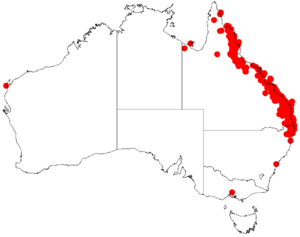Southern salwood facts for kids
Quick facts for kids Southern salwood |
|
|---|---|
| Scientific classification | |
| Genus: |
Acacia
|
| Species: |
disparrima
|
 |
|
| Occurrence data from AVH | |
The Acacia disparrima, also known as the southern salwood, is a type of shrub or tree. It belongs to the Acacia family and is originally from northeastern Australia.
Contents
What is the Southern Salwood?
How Big Does It Grow?
The southern salwood can grow as a shrub or a small tree. As a shrub, it usually reaches about 3 to 5 meters (10 to 16 feet) tall. If it grows into a tree, it can be anywhere from 3 to 9 meters (10 to 30 feet) tall, and sometimes even up to 12 meters (39 feet)!
What Does It Look Like?
This plant has bark that is grey-brown and looks cracked. Its branches are thin and angled at the ends. Like most Acacia plants, it doesn't have regular leaves. Instead, it has special flattened leaf stems called phyllodes.
These phyllodes are smooth and can be pale green to dark grey-green. They are curved like a sickle and measure about 5 to 14 centimeters (2 to 5.5 inches) long and 0.4 to 3 millimeters wide. They have many thin lines running along them.
When Does It Bloom?
The southern salwood blooms between January and May. Its flowers grow in groups that look like cylinders, about 2 to 7 centimeters (0.8 to 2.8 inches) long. The flowers are a pale yellow to lemon yellow color.
What About Its Seeds?
After blooming, the plant produces seed pods. These pods are smooth, a bit sticky, and can be straight or slightly curved and often twisted. They are woody and measure about 2.5 to 10 centimeters (1 to 4 inches) long and 10 to 20 millimeters (0.4 to 0.8 inches) wide. Inside, the seeds are arranged sideways, and they have a creamy grey to grey cord attached to them.
Where Does the Southern Salwood Live?
The southern salwood is found only in the coastal areas of Queensland and northern New South Wales in Australia. It also grows in the nearby tablelands in northern Queensland. In New South Wales, you can find it as far south as the Bellinger River. It likes to grow along the edges of rainforests and behind sand dunes near the coast. It is also part of wet sclerophyll forests and woodlands.
Who Discovered This Plant?
Naming the Southern Salwood
The southern salwood was officially described by two botanists, W.M.McDonald and Bruce Maslin, in the year 2000. They wrote about it in a scientific journal called Australian Systematic Botany.
A few years later, in 2003, another botanist named Leslie Pedley reclassified it. However, in 2006, it was moved back to the Acacia group. This plant has also been known by other names in the past, like Acacia aulacocarpa var. macrocarpa and Acacia leucadendron.
Related Plants
The southern salwood is very similar to another plant called Acacia aulacocarpa. People often get these two plants mixed up because they look so much alike!

